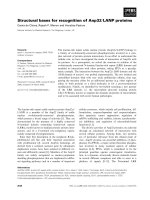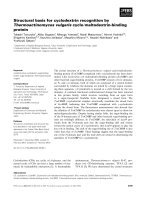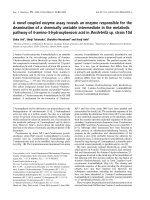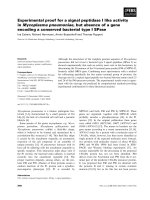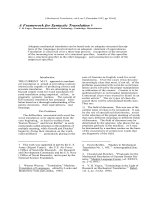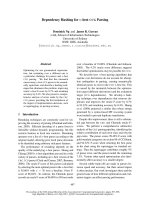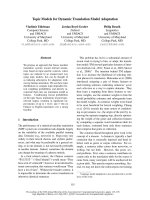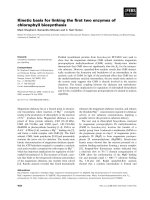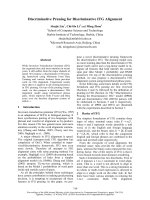Báo cáo khoa học: "Clustering Clauses for High-Level Relation Detection: An Information-theoretic Approach" pdf
Bạn đang xem bản rút gọn của tài liệu. Xem và tải ngay bản đầy đủ của tài liệu tại đây (420.78 KB, 8 trang )
Proceedings of the 45th Annual Meeting of the Association of Computational Linguistics, pages 448–455,
Prague, Czech Republic, June 2007.
c
2007 Association for Computational Linguistics
Clustering Clauses for High-Level Relation Detection: An
Information-theoretic Approach
Samuel Brody
School of Informatics
University of Edinburgh
Abstract
Recently, there has been a rise of in-
terest in unsupervised detection of high-
level semantic relations involving com-
plex units, such as phrases and whole
sentences. Typically such approaches are
faced with two main obstacles: data
sparseness and correctly generalizing
from the examples. In this work, we
describe the Clustered Clause represen-
tation, which utilizes information-based
clustering and inter-sentence dependen-
cies to create a simplified and generalized
representation of the grammatical clause.
We implement an algorithm which uses
this representation to detect a predefined
set of high-level relations, and demon-
strate our model’s effectiveness in over-
coming both the problems mentioned.
1 Introduction
The s emantic relationship between words, and
the extraction of meaning from syntactic data
has been one of the main points of research in
the field of computational linguistics (see Sec-
tion 5 and references therein). Until recently,
the fo cus has remained largely either at the sin-
gle word or sentence level (for instance: depen-
dency extraction, word-to-word semantic simi-
larity from syntax, etc.) or on relations between
units at a very high context level such as the
entire paragraph or document (e.g. categorizing
documents by topic).
Recently there have been several attempts to
define frameworks for detecting and studying in-
teractions at an intermediate context level, and
involving whole clauses or sentences. Dagan
et al. (2005) have emphasized the importance
of detecting textual-entailment/implication be-
tween two sentences, and its place as a key com-
ponent in many real-world applications, such as
Information Retrieval and Question Answering.
When designing such a framework, one is
faced with several obstacles. As we approach
higher levels of complexity, the problem of defin-
ing the basic units we study (e.g. words, sen-
tences etc.) and the increasing amount of in-
teractions make the task very difficult. In addi-
tion, the data sparseness problem becomes more
acute as the data units become more complex
and have an increasing number of possible val-
ues, despite the fact that many of these values
have similar or identical meaning.
In this paper we demonstrate an approach
to solving the complexity and data s parse-
ness problems in the task of detecting rela-
tions between sentences or clauses. We present
the Clustered Clause structure, which utilizes
information-based clustering and dependencies
within the sentence to create a simplified and
generalized representation of the grammatical
clause and is designed to overcome both these
problems.
The clustering method we employ is an inte-
gral part of the model. We evaluate our clusters
against semantic similarity measures defined on
the human-annotated WordNet structure (Fell-
baum, 1998). The results of these comparisons
show that our cluster members are very similar
semantically. We also define a high-level rela-
tion detection task involving relations between
clauses, evaluate our results, and demonstrate
448
the effectiveness of using our model in this task.
This work extends selected parts of Brody
(2005), where further details can be found.
2 Model Construction
When designing our framework, we must ad-
dress the complexity and sparseness problems
encountered when dealing with whole sentences.
Our solution to these iss ues combines two ele-
ments. First, to reduce complexity, we simplify
a grammatical clause to its primary components
- the subject, verb and object. Secondly, to pro-
vide a generalization framework which will en-
able us to overcome data-sparseness, we cluster
each part of the clause using data from within
the clause itself. By combining the simplified
clause structure and the clustering we produce
our Clustered Clause model - a triplet of clusters
representing a generalized clause.
The Simplified Clause: In order to extract
clauses from the text, we use Lin’s parser MINI-
PAR (Lin, 1994). The output of the parser is
a dependency tree of each sentence, also con-
taining lemmatized versions of the component
words. We extract the verb, subject and object
of every clause (including subordinate clauses),
and use this triplet of values, the simplified
clause, in place of the original complete clause.
As seen in Figure 1, these components make up
the top (root) triangle of the clause parse tree.
We also use the lemmatized form of the words
provided by the parser, to further reduce com-
plexity.
Figure 1: The parse tree for the sentence “John
found a solution to the problem”. The subject-
verb-object triplet is marked with a border.
Clustering Clause Components: For our
model, we cluster the data to provide both gen-
eralization, by using a cluster to represent a
more generalized concept shared by its compo-
nent words, and a form of dimensionality reduc-
tion, by using fewer units (clusters) to represent
a much larger amount of words.
We chose to use the Sequential Information
Bottleneck algorithm (Slonim et al., 2002) for
our clustering tasks. The information Bottle-
neck principle views the clustering task as an
optimization problem, where the clustering algo-
rithm attempts to group together values of one
variable while retaining as much information as
possible regarding the values of another (target)
variable. There is a trade-off between the com -
pactness of the clustering and the amount of re-
tained information. This algorithm (and others
based on the IB principle) is especially suited for
use with graphical models or dependency struc-
tures, since the distance measure it employs in
the clustering is defined solely by the depen-
dency relation between two variables, and there-
fore required no external parameters. The val-
ues of one variable are clustered using their co-
occurrence distribution with regard to the values
of the second (target) variable in the dependency
relation. As an example, consider the following
subject-verb co-occurrence matrix:
S \ V tell scratch drink
dog 0 4 5
John 4 0 9
cat 0 6 3
man 6 1 2
The value in cell (i, j) indicates the number
of times the noun i occurred as the subject of
the verb j. Calculating the Mutual Information
between the subjects variable (S) and verbs vari-
able (V) in this table, we get MI(S, V ) = 0.52
bits. Suppose we wish to cluster the subject
nouns into two clusters while preserving the
highest Mutual Information with regard to the
verbs. The following co-occurrence matrix is the
optimal clustering, and retains a M.I. value of
0.4 bits (77% of original):
Clustered S \ V tell scratch dr ink
{dog,cat} 0 10 8
{John,man} 10 1 11
Notice that although the values in the drink
column are higher than in others, and we may be
449
tempted to cluster together dog and John based
on this column, the informativeness of this verb
is smaller - if we know the verb is tell we can be
sure the noun is not dog or cat, whereas if we
know it is drink, we can only say it is slightly
more probable that the noun is John or dog.
Our dependency structure consists of three
variables: subject, verb, and object, and we take
advantage of the subject-verb and verb-object
dependencies in our clustering. The clustering
was performed on each variable separately, in
a two phase procedure (see Figure 2). In the
first stage, we clustered the subject variable into
200 clusters
1
, using the subject-verb dependency
(i.e. the verb variable was the target). The same
was done with the object variable, using the
verb-object dependency. In the second phase, we
wish to cluster the verb values with regard to
both the subject and object variables. We could
not use all pairs of subjects and objects values as
the target variable in this task, since too many
such combinations exist. Instead, we used a vari-
able composed of all the pairs of subject and ob-
ject clusters as the target for the verb clustering.
In this fashion we produced 100 verb clusters.
Figure 2: The two clustering phases. Arrows rep-
resent dependencies between the variables which
are used in the clustering.
Combining the Model Elements: Having
obtained our three clustered variables, our orig-
inal simplified clause triplet can now be used
to produce the Clustered Clause model. This
model represents a clause in the data by a triplet
of cluster indexes, one cluster index for each
clustered variable. In order to map a clause in
1
The chosen numbers of clusters are such that each
the res ulting clustered variables preserved approximately
half of the co-occurrence mutual information that existed
between the original (unclustered) variable and its target.
the text to its corresponding clustered clause,
it is first parsed and lemmatized to obtain the
subject, verb and object values, as describ ed
above, and then assigned to the clustered clause
in which the subject cluster index is that of
the cluster containing the subject word of the
clause, and the same for the verb and object
words. For example, the sentence “The terrorist
threw the grenade” would be converted to the
triplet (terrorist, throw, grenade) and assigned
to the clustered clause composed of the three
clusters to which these words belong. Other
triplets assigned to this clustered clause might
include (fundamentalist, throw, bomb) or (mil-
itant, toss, explosive). Applying this procedure
to the entire text corpus results in a distilla-
tion of the text into a series of clustered clause s
containing the essential information about the
actions described in the text.
Technical Specifications: For this work we
chose to use the entire Reuters Corpus (En-
glish, release 2000), containing 800,000 news
articles collected uniformly from 20/8/1996 to
19/8/1997. Before clustering, several prepro-
cessing steps were taken. We had a very large
amount of word values for each of the Sub-
ject (85,563), Verb (4,593) and Object (74,842)
grammatical categories. Many of the words were
infrequent proper nouns or rare verbs and were
of little interest in the pattern recognition task.
We therefore removed the less frequent words
- those appearing in their category less than
one hundred times. We also cleaned our data
by removing all words that were one letter in
length, other than the word ‘I’. These were
mostly initials in names of p eople or compa-
nies, which were uninformative without the sur-
rounding context. This processing step brought
us to the final count of 2,874,763 clause triplets
(75.8% of the original number), containing 3,153
distinct subjects , 1,716 distinct verbs, and 3,312
distinct objects. These values were clustered as
described above. The clusters were used to con-
vert the s implified clauses into clustered clauses.
3 Evaluating Cluster Quality
Examples of some of the resulting clusters are
provided in Table 1. When manually examin-
450
“Technical Developements” (Subject
Cluster 160): treatment, drug, method, tactic,
version, technology, software, design, device, vaccine,
ending, tool, mechanism, technique, instrument,
therapy, concept, model
“Ideals/Virtues” (Object Cluster 14):
sovereignty, dominance, logic, validity, legitimacy,
freedom, discipline, viability, referendum, w isdom ,
innocence, credential, integrity, independence
“Emphasis Verbs” (Verb Cluster 92): im-
ply, signify, highlight, mirror, exacerbate, mark, sig-
nal, underscore, compound, precipitate, mask, illus-
trate, herald, reinforce, suggest, underline, aggra-
vate, reflect, demonstrate, spell, indicate, deepen
“Plans” (Object Cluster 33): journey, ar-
rangement, trip, effort, attempt, revolution, pull-
out, handover, sweep, preparation, filing, start, play,
repatriation, redeployment, landing, visit, push,
transition, process
Table 1: Example clusters (labeled manually).
ing the clusters, we noticed the “fine-tuning”
of some of the clusters. For instance, we had
a cluster of countries involved in military con-
flicts, and another for other countries; a cluster
for winning game scores, and another for ties;
etc. The fact that the algorithm separated these
clusters indicates that the distinction between
them is important with regard to the interac-
tions within the clause. For instance, in the first
example, the context in which countries from the
first cluster appear is very different from that in-
volving countries in the second cluster.
The effect of the dependencies we use is also
strongly felt. Many clusters can be described by
labels such as “things that are thrown” (rock,
flower, bottle, grenade and others), or “verbs
describing attacks” (spearhead, foil, intensify,
mount, repulse and others). While such crite-
ria may not be the first choice of someone who
is asked to cluster verbs or nouns, they repre-
sent unifying themes which are very appropri-
ate to pattern detection tasks, in which we wish
to detect connections between actions described
in the c lauses. For instance, we would like to
detect the relation b etween throwing and mil-
itary/police action (much of the throwing de-
scribed in the news reports fits this relation). In
order to do this, we must have clusters which
unite the words relevant to those actions. Other
criteria for clustering would most likely not be
suitable, since they would probably not put egg,
bottle and rock in the same category. In this re-
spect, our clustering method provides a more
effective modeling of the domain knowledge.
3.1 Evaluation via Semantic Resource
Since the success of our pattern detection task
depends to a large extent on the quality of our
clusters, we performed an experiment des igned
to evaluate semantic similarity between mem-
bers of our clusters. For this purp os e we made
use of the WordNet Similarity package (Peder-
sen et al., 2004). This package contains many
similarity measures, and we selected three of
them (Resnik (1995), Leacock and Chodorow
(1997), Hirst and St-Onge (1997)), which make
use of different aspects of WordNet (hierarchy
and graph structure). We measured the average
pairwise similarity between any two words ap-
pearing in the same cluster. We then performed
the same calculation on a random grouping of
the words, and compared the two scores. The re-
sults (Fig. 3) show that our clustering, based on
co-occurrence statistics and dependencies within
the se ntence, correlates with a purely semantic
similarity as represented by the WordNet struc-
ture, and cannot be attributed to chance.
Figure 3: Inter-cluster similarity (average pair-
wise similarity between cluster members) in our
clustering (light) and a random one (dark). Ran-
dom clustering was performed 10 times. Aver-
age values are shown with error bars to indicate
standard deviation. Only Hirst & St-Onge mea-
sure verb similarity.
4 Relation Detection Task
Motivation: In order to demonstrate the use
of our model, we chose a relation detection task.
The workshop on entailment mentioned in the
introduction was mainly focused on detecting
whether or not an entailment relation exists be-
tween two texts. In this work we present a com-
451
plementary approach - a method designed to au-
tomatically detect relations between portions of
text and generate a knowledge base of the de-
tected relations in a generalized form. As stated
by (Dagan et al., 2005), such relations are im-
portant for IR applications. In addition, the pat-
terns we employ are likely to be useful in other
linguistic tasks involving whole clauses, such as
paraphrase acquisition.
Pattern Definition: For our relation detec-
tion task, we searched for instances of prede-
fined patterns indicating a relation between two
clustered clauses. We restricted the search to
clause pairs which co-occur within a distance of
ten clauses
2
from each other. In addition to the
distance restriction, we required an anchor: a
noun that appears in both clauses, to further
strengthen the relation between them. Noun an-
chors establish the fact that the two compo-
nent actions described by the pattern involve the
same entities, implying a direct connection be-
tween them. The use of verb anchors was also
tested, but found to be less helpful in detect-
ing significant patterns, since in most cases it
simply found verbs which tend to repeat them-
selves frequently in a context. The method we
describe assumes that statistically significant co-
occurrences indicate a relationship between the
clauses, but does not attempt to determine the
type of relation.
Significance Calculation: The patterns de-
tected by the system were scored using the sta-
tistical p-value measure. This value represents
the probability of detecting a certain number
of occurrences of a given pattern in the data
under the independence assumption, i.e. assum-
ing there is no connection between the two
halves of the pattern. If the system has detected
k instances of a certain pattern, we calculate
the probability of encountering this number of
instances under the independence assumption.
The smaller the probability, the higher the sig-
nificance. We consider patterns with a chance
probability lower than 5% to be significant.
We assume a Gaussian-like distribution of oc-
2
Our experiments showed that increasing the distance
beyond this point did not result in significant increase in
the number of detected patterns.
currence probability for each pattern
3
. In or-
der to estimate the mean and standard devia-
tion values, we created 100 simulated sequences
of triplets (representing clustered clauses) which
were independently distributed and varied only
in their overall probability of occurrence. We
then estimated the mean and standard devia-
tion for any pair of clauses in the actual data
using the simulated sequences.
(X, V C
36
, OC
7
) →
10
(X, V C
57
, OC
85
)
storm, lash, province storm, cross, Cuba
quake, shake, city quake, hit, Iran
earthquake, jolt, city earthquake, hit, Iran
(X, V C
40
, OC
165
) →
10
(X, V C
52
, OC
152
)
police, arrest, leader police, search, mos que
police, detain, leader police, search, mosque
police, arrest, member police, raid, enclave
(SC
39
, V C
21
, X) →
10
(X, beat
4
, OC
155
)
sun, report, earnings earnings,beat,expectation
xerox, report, earnings earnings, beat, forecast
microsoft,release,result result, beat, forecast
(X, V C
57
, OC
7
) →
10
(X, cause
4
, OC
153
)
storm, hit, coast storm, cause, damage
cyclone, near, coast cyclone, cause, damage
earthquake,hit,northwest earthquake,cause,damage
quake , hit, northwest quake, cause, casualty
earthquake,hit,city earthquake,cause,damage
Table 2: Example Patterns
4.1 Pattern Detection Results
In Table 2 we present several examples of
high ranking (i.e. significance) patterns with
different anchorings detected by our method.
The detected patterns are represented using
the notation of the form (SC
i
, V C
j
, X) →
n
(X, V C
i
, OC
j
). X indicates the anchoring
word. In the example notation, the anchoring
word is the object of the first clause and the
subject of the second (O-S for short). n indicates
the maximal distance between the two clauses.
The terms SC, V C or OC with a subscripted
index represent the cluster containing the sub-
ject, verb or object (respectively) of the appro-
priate clause. For instance, in the first example
in Table 2, V C
36
indicates verb cluster no. 36,
containing the verbs lash, shake and jolt, among
others.
3
Based on Gwadera et al. (2003), dealing with a sim-
ilar, though simpler, case.
4
In two of the patterns, instead of a cluster for the
verb, we have a single word - beat or cause. This is the
result of an automatic post-processing stage intended to
prevent over-generalization. If all the instances of the pat-
452
Anchoring Number of
System Patterns Found
Subject-Subje ct 428
Object-Object 291
Subject-Object 180
Object-Subject 178
Table 3: Numbers of patterns found (p < 5%)
Table 3 lists the number of patterns found,
for each anchoring system. The different anchor-
ing systems produce quantitatively different re-
sults. Anchoring between the same categories
produces more patterns than between the same
noun in different grammatical roles. This is ex-
pected, since many nouns can only play a certain
part in the clause (for instance, many verbs can-
not have an inanimate entity as their subject).
The number of instances of patterns we found
for the anchored template might be considered
low, and it is likely that some patterns were
missed simply because their o cc urrence proba-
bility was very low and not enough instances of
the pattern occurred in the text. In Section 4 we
stated that in this task, we were more interested
in precision than in recall. In order to detect a
wider range of patterns, a less restricted defini-
tion of the patterns, or a different significance
indicator, should be used (see Sec. 6).
Human Evaluation: In order to better de-
termine the quality of patterns detected by our
system, and confirm that the statistical signif-
icance testing is consistent with human judg-
ment, we performed an evaluation experiment
with the help of 22 human judges. We presented
each of the judges with 60 example groups, 15
for each type of anchoring. Each example group
contained three clause pairs conforming to the
anchoring relation. The clauses were presented
in a normalized form consisting only of a sub-
ject, object and verb converted to past tense,
with the addition of necessary determiners and
prepositions. For example, the triplet (police,
detain, leader) was converted to “The police de-
tained the leader”. In half the cases (randomly
tern in the text contained the same word in a certain po-
sition (in these examples - the verb position in the second
clause), this word was placed in that position in the gen-
eralized pattern, rather than the cluster it belonged to.
Since we have no evidence for the fact that other words
in the cluster can fit that position, using the cluster in-
dicator would be over-generalizing.
selected), these clause pairs were actual exam-
ples (instances) of a pattern detected by our sys-
tem (instances group), s uch as those appearing
in Table 2. In the other half, we listed three
clause pairs, each of which conformed to the
anchoring specification listed in Section 4, but
which were randomly sampled from the data,
and so had no connection to one another (base-
line group). We asked the judges to rate on a
scale of 1-5 whether they thought the clause
pairs were a good set of examples of a common
relation linking the first clause in each pair to
the sec ond one.
Instances Instances Baseline Baseline
Score StdDev Score StdDev
All 3.5461 0.4780 2.6341 0.4244
O-S 3.9266 0.6058 2.8761 0.5096
O-O 3.4938 0.5144 2.7464 0.6205
S-O 3.4746 0.7340 2.5758 0.6314
S-S 3.2398 0.4892 2.3584 0.5645
Table 4: Results for human evaluation
Table 4 reports the overall average scores for
baseline and instances groups, and for each of
the four anchoring types individually. The scores
were averaged over all examples and all judges.
An ANOVA showed the difference in scores be-
tween the baseline and instance groups to be
significant (p < 0.001) in all four cases.
Achievement of Model Goals: We em-
ployed clustering in our model to overcome data-
sparseness. The importance of this decision was
evident in our results. For example, the second
pattern shown in Table 2 appeared only four
times in the text. In these instances, verb cluster
40 was represented twice by the verb arrest and
twice by detain. Two appearances are within the
statistical deviation of all but the rarest words,
and would not have been detected as significant
without the clustering effect. T his means the
pattern would have been overlooked, despite the
strongly intuitive connection it represents. The
system detected several such patterns.
The other reason for clustering was general-
ization. Even in cases where patterns involving
single words could have been detected, it would
have been impossible to unify similar patterns
into generalized ones. In addition, when encoun-
tering a new clause which differs slightly from
453
the ones we recognized in the original data, there
would be no way to rec ognize it and draw the ap-
propriate conclusions. For example, there would
be no way to relate the sentence “The typhoon
approached the coast” to the fourth example pat-
tern, and the connection with the resulting dam-
age would not be recognized.
5 Comparison with Previous Work
The relationship between textual features and
semantics and the use of syntax as an indica-
tor of semantics has been widespread. Following
the idea proposed in Harris’ Distributional Hy-
pothesis (Harris, 1985), that words occurring in
similar contexts are semantically similar, many
works have used different definitions of context
to identify various types of semantic similarity.
Hindle (1990) uses a mutual-information based
metric derived from the distribution of subject,
verb and object in a large corpus to classify
nouns. Pereira et al. (1993) cluster nouns ac-
cording to their distribution as direct objects
of verbs, using information-theoretic tools (the
predecessors of the tools we use in this work).
They suggest that information theoretic mea-
sures can also measure semantic relatedness.
These works focus only on relatedness of indi-
vidual words and do not describe how the au-
tomatic estimation of semantic similarity can
be useful in real-world tasks. In our work we
demonstrate that using clusters as generalized
word units helps overcome the sparseness and
generalization problems typically encountered
when attempting to extract high-level patterns
from text, as required for many applications.
The DIRT system (Lin and Pantel, 2001)
deals with inference rules, and employs the no-
tion of paths between two nouns in a sentence’s
parse tree. The system extracts such path struc-
tures from text, and provides a similarity mea-
sure between two such paths by comparing the
words which fill the same slots in the two paths.
After extracting the paths, the system finds
groups of similar paths. This approach bears
several similarities to the ideas described in this
paper, since our s tructure can be seen as a
specific path in the parse tree (probably the
most basic one, see Fig. 1). In our setup, sim-
ilar clauses are clustered together in the same
Clustered-Clause, which could be compared to
clustering DIRT’s paths using its similarity mea-
sure. Despite these similarities, there are several
important differences between the two systems.
Our method uses only the relationships inside
the path or clause in the clustering procedure,
so the similarity is based on the structure it-
self. Furthermore, Lin and Pantel did not create
path clusters or generalized paths, so that while
their method allowed them to compare phrases
for similarity, there is no convenient way to iden-
tify high level contextual relationships between
two nearby sentences. This is one of the signifi-
cant advantages that clustering has over similar-
ity measures - it allows a group of similar objects
to be represented by a single unit.
There have been several attempts to formu-
late and detect relationships at a higher context
level. The VerbOcean project (Chklovski and
Pantel, 2004) deals with relations between verbs.
It presents an automatically ac quired network
of such relations, similar to the WordNet frame-
work. Though the patterns used to acquire the
relations are usually parts of a single sentence,
the relationships themselves can also be used
to describe connections between different sen-
tences, especially the enablement and happen s-
before relations. Since verbs are the central part
of the clause, VerbOcean can be viewed as de-
tecting relations between clauses as whole units,
as well as those between individual words. As
a solution to the data sparseness problem, web
queries are used. Torisawa (2006) addresses a
similar problem, but focuses on temporal re-
lations, and makes use of the phenomena of
Japanese coordinate sentences. Neither of these
approaches attempt to create generalized rela-
tions or group verbs into clusters, though in
the case of VerbOcean this could presumably
be done using the similarity and strength values
which are defined and detected by the system.
6 Future Work
The clustered clause model presents many di-
rections for further research. It may be produc-
tive to extend the model further, and include
other parts of the sentence, such as adjectives
454
and adverbs. Clustering nouns by the adjectives
that describe them may provide a more intu-
itive grouping. The addition of further elements
to the structure may also allow the detection of
new kinds of relations.
The news-oriented domain of the corpus we
used strongly influenced our results. If we were
interested in more mundane relations, involving
day-to-day actions of individuals, a literary cor-
pus would probably be more suitable.
In defining our pattern template, several ele-
ments were tailored spe cifically to our task. We
limited ourselves to a very restricted set of pat-
terns in order to better demonstrate the effec-
tiveness of our model. For a more general knowl-
edge acquisition task, several of these restric-
tions may be relaxed, allowing a much larger
set of relations to be detected. For example, a
less strict significance filter, such as the support
and confidence measures commonly used in data
mining, may be preferable. These can be set to
different thresholds, according to the user’s pref-
erence.
In our current work, in order to prevent over-
generalization, we employed a single step post-
processing algorithm which detected the incor-
rect use of an entire cluster in place of a single
word (see footnote for Table 2). This method
allows only two levels of generalization - sin-
gle words and whole clusters. A more appro-
priate way to handle generalization would be
to use a hierarchical clustering algorithm. The
Agglomerative Information Bottleneck (Slonim
and Tishby, 1999) is an example of such an al-
gorithm, and could be employed for this task.
Use of a hierarchical method would result in
several levels of clusters, representing different
levels of generalization. It would be relatively
easy to modify our procedure to reduce general-
ization to the level indicated by the pattern ex-
amples in the text, producing a more accurate
description of the patterns detected.
Acknowledgments
The author acknowledges the support of EPSRC grant
EP/C538447/1. The author would like to thank Naftali
Tishby and Mirella Lapata for their supervision and as-
sistance on large portions of the work presented here. I
would also like to thank the anonymous reviewers and
my friends and colleagues for their helpful comments.
References
Bro dy, Samuel. 2005. Cluster-Based Pattern Recognition
in Natural Language Text. Master’s thesis, Hebrew
University, Jerusalem, Israel.
Chklovski, T. and P. Pantel. 2004. Verbocean: Mining
the web for fine-grained semantic verb relations. In
Proc. of EMNLP. pages 33–40.
Dagan, I., O. Glickman, and B. Magnini. 2005. The
pascal recognising textual entailment challenge. In
Proceedings of the PASCAL Challenges Workshop on
Recognising Textual Entailment.
Fellbaum, Christiane, editor. 1998. WordNet: An Elec-
tronic Database. MIT Press, Cambridge, MA.
Gwadera, R., M. Atallah, and W. Szpankowski. 2003.
Reliable detection of episodes in event sequences. In
ICDM .
Harris, Z. 1985. Distributional structure. Katz, J. J.
(ed.) The Philosophy of Linguistics pages 26–47.
Hindle, Donald. 1990. Noun classification from predicate-
argument structures. In Meeting of the ACL. pages
268–275.
Hirst, G. and D. St-Onge. 1997. Lexical chains as repre-
sentation of context for the detection and correction
of malapropisms. In WordNet: An Electronic Lexical
Database, ed., Christiane Fellbaum. MIT Press.
Leacock, C. and M. Chodorow. 1997. Combining local
context and wordnet similarity for word sense identi-
fication. In WordNet: An Electronic Lexical Database,
ed., Christiane Fellbaum. MIT Press.
Lin, Dekang. 1994. Principar - an efficient, broad-
coverage, principle-based parser. In COLING. pages
482–488.
Lin, Dekang and Patrick Pantel. 2001. DIRT - discovery
of inference rules from text. In Know ledge Discovery
and Data Mining. pages 323–328.
Pedersen, T ., S. Patwardhan, and J. Michelizzi. 2004.
Wordnet::similarity - measuring the relatedness of con-
cepts. In Proc. of AAAI-04 .
Pereira, F., N. Tishby, and L. Lee. 1993. Distributional
clustering of english words. In Meeting of the Associ-
ation for Computational Linguistics. pages 183–190.
Resnik, Philip. 1995. Using information content to eval-
uate semantic similarity in a taxonomy. In IJCAI .
pages 448–453.
Slonim, N., N. Friedman, and N. Tishby. 2002. Unsu-
pervised document classification using sequential in-
formation maximization. In Proc. of SIGIR’02 .
Slonim, N. and N. Tishby. 1999. Agglomerative informa-
tion bottleneck. In Proc. of NIPS-12 .
Torisawa, Kentaro. 2006. Acquiring inference rules with
temporal constraints by using japanese coordinated
sentences and noun-verb co-occurrences. In Proceed-
ings of NAACL. pages 57–64.
455

